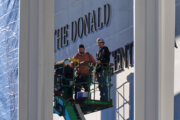WASHINGTON — Concrete core samples taken from a crumbling bridge carrying Metro’s Red Line have been sent for testing ahead of repairs set to begin next month.
Crews took the samples Wednesday night from a bridge outside the Rhode Island Avenue Station.
Metro is planning extensive work to repair the concrete during a three-week Red Line shutdown in the area that had been set to begin in early October. The concrete is expected to be set and the repairs completed by the end of November. The new schedule for the next round of work zones is expected to be announced within the next two weeks.
Inspections in the area of the Rhode Island Station uncovered the concrete damage, which does not pose a safety risk to riders, Metro said. However outbound trains approaching the station are under 15 mph speed restrictions as a precaution to prevent further damage to the bridge.
The inspections were ordered after concrete and metal fell inside the outdoor station last week.
“We open up a closet door and something else falls out and hits us in the head,” Metro Board Chairman and D.C. Councilmember Jack Evans said Thursday. “We are ongoing, learning about new things every day where Washington Metro has, because of this complete lack of maintenance over 15 years, has been in a deficient place.”
Federal investigations have found maintenance, inspection and procedural failures that go back decades in some cases, including track inspectors who could not do their jobs and safety policies that were completely ignored.
“You need a detailed inspection program to monitor the concrete and constantly do that on a regular basis and maintain it where you can and try to do that in nonrevenue service,” General Manager Paul Wiedefeld said.
A Metro Board committee Thursday heard the first formal presentation on a plan to reduce service hours in order to give maintenance crews more time to work on the tracks and equipment.
“The bottom line here is we have to do this. We’re going to have to do this work. No matter when we do it, we have to do it,” Wiedefeld said after the meeting.
“We see a problem, now we’ve got all these other problems, we start to prioritize them, so you’re hitting the most important first. Meanwhile, these things are piling up and piling up, and that’s what has been the constant theme through any of the investigations that have been done here is that that’s what’s broken. You have to get that workload down, and to do that you’ve got to constantly inspect, you’ve got to constantly maintain,” he said.
Wiedefeld plans a long list of new, regular inspections to take place overnight while the system is closed to the public. He has hired a number of independent consultants to gauge where the system stands today in key areas.







